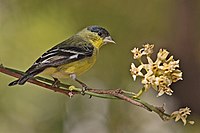
Photo from wikipedia
Free-ranging animals are often used as bioindicators of both short- and long-term changes in ecosystem health, mainly to detect the presence and effects of contaminants. Birds, and gulls in particular,… Click to show full abstract
Free-ranging animals are often used as bioindicators of both short- and long-term changes in ecosystem health, mainly to detect the presence and effects of contaminants. Birds, and gulls in particular, have been used as bioindicators over a broad range of marine and terrestrial ecosystems. In this study, we standardise the conditions for the use of a suite of biochemical markers in non-destructive matrices of Lesser Black-backed Gull (Larus fuscus) to facilitate future biomonitoring of marine and terrestrial contaminants. We characterized cholinesterase (ChE) in plasma and optimized assay conditions for ChE activity as a marker of neurotoxic damage. Moreover, we quantified variation in activity of ChE, lactate dehydrogenase (LDH), glutathione-S-transferase (GST) and catalase (CAT) as well as variation ranges of lipid peroxidation (LPO), in free-ranging adults and captive chicks. The main ChE form present in plasma of both adults and chicks was butyrylcholinesterase (BChE) followed by acetylcholinesterase (AChE), whose relative proportion in plasma tended to decrease with increased chick age. LPO levels and GST activity in blood cells (BCs) decreased significantly with increasing chick age, while BChE and LDH activity in plasma were not age-dependent. CAT in BCs tended to decline non-significantly in older chicks. Results of this study underscore the importance of standardising assay conditions and assessing intrinsic baseline variation in biochemical markers, before biochemical quantification. Data presented here provide a foundation for future use of BChE and LDH activity in plasma, as well as oxidative stress markers (LPO, CAT and GST) in BCs, to monitor environmental stress effects in Lesser Black-backed gulls.
Journal Title: Ecotoxicology and environmental safety
Year Published: 2019
Link to full text (if available)
Share on Social Media: Sign Up to like & get
recommendations!